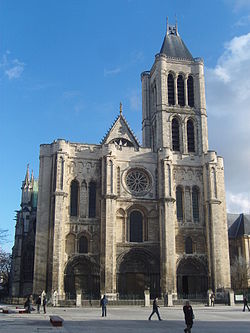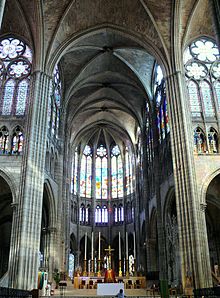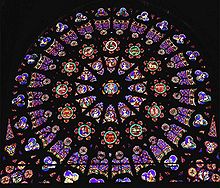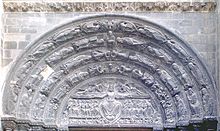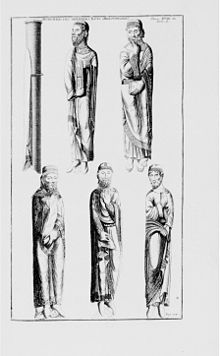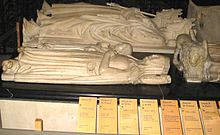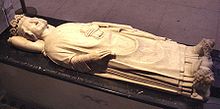- Basilica of St Denis
-
The Cathedral Basilica of Saint Denis (French: Cathédrale royale de Saint-Denis, or simply Basilique Saint-Denis, previously the Abbaye de Saint-Denis) is a large medieval abbey church in the commune of Saint-Denis, now a northern suburb of Paris. The abbey church was created a cathedral in 1966 and is the seat of the Bishop of Saint-Denis, Pascal Michel Ghislain Delannoy. The building is of unique importance historically and architecturally.
Founded in the 7th century by Dagobert I on the burial place of Saint Denis, a patron saint of France, the church became a place of pilgrimage and the burial place of the French Kings, nearly every king from the 10th to the 18th centuries being buried there, as well as many from the previous centuries. (It was not used for the coronations of kings, this role being designated to the Cathedral of Reims; however, queens were commonly crowned there.) "Saint-Denis" soon became the abbey church of a growing monastic complex. In the 12th century the Abbot Suger rebuilt portions of the abbey church using innovative structural and decorative features that were drawn from a number of other sources. In doing so, he is said to have created the first truly Gothic building.[1] The basilica's 13th century nave is also the prototype for the Rayonnant Gothic style, and provided an architectural model for cathedrals and abbeys of northern France, England and other countries.
Contents
Background
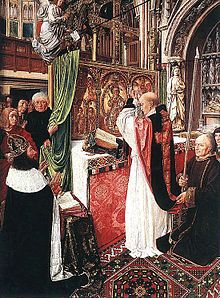 15th century painting by the Master of Saint Giles, showing St Denis saying mass before Charlemagne or Charles Martel with what is thought to be a largely accurate view of the abbey with a crux gemmata given by Charles the Bald and gold altar frontal, both destroyed in the Revolution.
15th century painting by the Master of Saint Giles, showing St Denis saying mass before Charlemagne or Charles Martel with what is thought to be a largely accurate view of the abbey with a crux gemmata given by Charles the Bald and gold altar frontal, both destroyed in the Revolution.
Saint Denis is a patron saint of France and, according to legend, was the first bishop of Paris. Following his decapitation on the Hill of Montmartre, Denis supposedly carried his head to the site of the current church, thereby indicating where he wanted to be buried. A martyrium was subsequently erected on the site. There Dagobert I, king of the Franks (reigned 628 to 637), founded the Abbey of Saint Denis, a Benedictine monastery. Dagobert also commissioned a new shrine to house the saint's remains, which was created by his chief councillor, Eligius, a goldsmith by training. It was described in an early vita of Saint Eligius:
- Above all, Eligius fabricated a mausoleum for the holy martyr Denis in the city of Paris with a wonderful marble ciborium over it marvelously decorated with gold and gems. He composed a crest [at the top of a tomb] and a magnificent frontal and surrounded the throne of the altar with golden axes in a circle. He placed golden apples there, round and jeweled. He made a pulpit and a gate of silver and a roof for the throne of the altar on silver axes. He made a covering in the place before the tomb and fabricated an outside altar at the feet of the holy martyr. So much industry did he lavish there, at the king's request, and poured out so much that scarcely a single ornament was left in Gaul and it is the greatest wonder of all to this very day.[2]
None of this work survives.
Architecture
The Basilica of St Denis is an architectural landmark as it was the first major structure of which a substantial part was designed and built in the Gothic style. Both stylistically and structurally it heralded the change from Romanesque architecture to Gothic architecture. Before the term "Gothic" came into common use, it was known as the "French Style" (Opus Francigenum).
As it now stands, the church is a large cruciform building of "basilica" form, that is, it has a central nave with lower aisles and clerestory windows. It has an additional aisle on the northern side formed of a row of chapels. The west front has three portals, a rose window and one tower, on the southern side. The eastern end, which is built over a crypt, is apsidal, surrounded by an ambulatory and a chevet of nine radiating chapels. The basilica retains stained glass of many periods (although most of the panels from Suger's time have been removed for long-term conservation and replaced with photographic transparencies), including exceptional modern glass, and a set of twelve misericords.
The Carolingian church
Little is known about the earliest buildings on the site. The first church mentioned in the chronicles was begun in 754 under Pepin the Short and completed under Charlemagne, who was present at its consecration in 775. Most of what is now known about the Carolingian church at St Denis resulted from a lengthy series of excavations begun under the American art historian Sumner McKnight Crosby in 1937.[3] The building was about 60m long, with a monumental westwork, single transepts, a crossing tower and a lengthy eastern apse over a large crypt (parts of which survive). According to one of the Abbey's many foundation myths a leper, who was sleeping in the nearly-completed church the night before its planned consecration, witnessed a blaze of light from which Christ, accompanied by St Denis and a host of angels emerged to conduct the consecration ceremony himself. Before leaving, Christ healed the leper, tearing off his diseased skin to reveal a perfect complexion underneath. A mishapen patch on a marble column was said to be the leper's former skin, which stuck there when Christ discarded it. Fantastical though they may seem now, the popularity of such myths in medieval accounts go some way to explaining why any redevelopment of the original church was a sensitive matter and why Suger found it necessary to go to such lengths to justify his changes. Having been consecrated by Christ, the fabric of the building was itself regarded as sacred.[4]
The Early Gothic rebuilding
Abbot Suger (circa 1081-1151), friend and confidant of French kings and Abbot of St Denis from 1122, began work around 1135 on the rebuilding and enlarging of the abbey to which he had been given as an oblate at the age of 10. In his famous account of the work undertaken during his administration, Suger was careful to explain and justify his decision to rebuild the church, complaining at length about the parlous state of the old structure and its inability to cope with the crowds of pilgrims visiting the shrine of St Denis, particularly
...on special days such as the feast of the blessed Denis [...] when the narrowness of the place forced women to run to the altar on the heads of men as on a pavement with great anguish and confusion.[5]
It is important to emphasise that Suger was the patron of the rebuilding of St Denis but not the architect, as was often assumed in the 19th and early 20th centuries.[6] In fact it appears that two distinct architects, or master masons, were involved in the 12th century changes. Both remain anonymous but their work can be distinguished on stylistic grounds. The first, who was responsible for the initial work at the western end, favoured conventional Romanesque capitals and moulding profiles with rich and individualised detailing. His successor, who completed the western facade and upper stories of the narthex, before going on to build the new choir, displayed a more restrained approach to decorative effects, relying on a simple repertoire of motifs, which may have proved more suitable for the lighter Gothic style that he helped to create.[7]
First phase - the westwork, c.1135-40
Suger began his rebuilding project at the western end of St Denis, demolishing the old Carolingian westwork, with its single, centrally located door. He extended the old nave westwards by an additional four bays and added a massive western narthex, incorporating a new façade and three chapels on the first floor level. This new westwork, 34m wide and 20m deep, featured three great doorways, the central one larger than those either side, reflecting the relative sizes of the nave's central vessel and lateral aisles within. This tripartite arrangement was clearly influenced by the late 11th century façades of the abbey churches of St Etienne and La Trinité in Caen, 150 miles to the west, with which it also shared a three story elevation and flanking towers (of which only the south tower survives, its partner having been dismantled following clumsy repairs in the 1840s).
The major innovation in the façade at St Denis is the way the unknown architects have chosen to emphasise the divisions between the different parts, with massive vertical buttresses separating the three doorways and with horizontal string-courses and window arcades clearly marking out the vertical divisions. As well as its obvious influence on subsequent west façade designs, this clear delineation of parts is a common theme in the development of Gothic architecture and a marked departure from earlier Romanesque designs. Also innovative was the rose window at the centre of the upper story of the west portal (destroyed during the Revolution - the current window is a 19th century replacement). Although small circular windows (oculi) within triangular tympana were common on the west facades of Italian Romanesque churches, this was probably the first example of a rose window within a square frame, which was to become a dominant feature of the Gothic facades of northern France (soon to be imitated at Chartres Cathedral and many others).[8] The overall design of the façade has an obvious resemblance to a Roman city gatehouse (an impression strengthened by the buttresses and by the crenellations around the top), which helps to emphasise the traditional notion of great churches as earthly embodiments of the Heavenly City, as described in the Book of Ezekiel.
Among the many influential features of the new façade were the tall, thin statues of Old Testament prophets and kings attached to columns (jamb figures) flanking the portals (destroyed in 1771 but recorded in Montfaucon's drawings). These were also adopted at the cathedrals of Paris and Chartres, constrcuted a few years later, and became a feature of almost every Gothic portal thereafter. Above the doorways, the central tympanum was carved with a Last Judgement scene; Christ enthroned, displaying his wounds with the dead emerging from their tombs below. Scenes from the martyrdom of St Denis were carved above the south (right hand) portal, while above the north portal was a mosaic (lost), even though this was, as Suger put it 'contrary to the modern custom'. Of the original sculpture, very little remains, most of what is now visible being the result of rather clumsy restoration work in 1839.[9]. Some fragments of the original sculptures survive in the collection of the Musée de Cluny. The portals themselves were sealed by gilded bronze doors, ornamented with scenes from Christ's Passion and clearly recording Suger's patronage with the following inscription;
For the glory of the church which nurtured and raised him, Suger strove for the glory of the church, Sharing with you what is yours, oh martyr Denis. He prays that by your prayers he should become a sharer in Paradise. The year when it was consecrated was the one thousand, one hundred and fortieth year of the Word.[10]
On the lintel below the great tympanum showing the Last Judgement, beneath a carved figure of the kneeling Abbot, was inscribed the more modest plea;
Receive, stern Judge, the prayers of your Suger, Let me be mercifully numbered among your sheep.
Suger's western extension was completed in 1140 and the three new chapels in the narthex were consecrated on 9th June of that year.
Second phase - the new choir, 1140-44
On completion of the west front, Abbot Suger moved on to the reconstruction of the eastern end, leaving the Carolingian nave in use. He wanted a choir (chancel) that would be suffused with light. To achieve his aims, Suger's masons drew on the several new elements which evolved or had been introduced to Romanesque architecture: the pointed arch, the ribbed vault, the ambulatory with radiating chapels, the clustered columns supporting ribs springing in different directions and the flying buttresses which enabled the insertion of large clerestory windows.
It was the first time that these features had all been drawn together. Erwin Panofsky argued that Suger was inspired to create a physical representation of the Heavenly Jerusalem, however the extent to which Suger had any aims higher than aesthetic pleasure has been called into doubt by more recent art historians on the basis of Suger's own writings.
The new structure was finished and dedicated on June 11, 1144, in the presence of the King.[11] The Abbey of St Denis thus became the prototype for further building in the royal domain of northern France. Through the rule of the Angevin dynasty, the style was introduced to England and spread throughout France, the Low Countries, Germany, Spain, northern Italy and Sicily.[12][13]
In 1231, Abbot Odo Clement began work on the rebuilding of the Carolingian nave, which remained sandwiched incongruously between Suger's far more up-to-date Gothic works to the east and west. From the start it appears that Abbot Odo, with the approval of the Regent Blanche of Castille and her son, the young King Louis IX, planned for the new nave and its large crossing to have a much clearer focus as the French 'royal necropolis'. That plan was fulfilled in 1264 when the bones of 16 former kings and queens were relocated to new tombs arranged around the crossing - 8 Carolingian monarchs to the south and 8 Capetians the north.[14] These tombs, featuring life-like carved recumbent effigies or gisants lying on raised bases, were badly damaged during the French revolution though all but two were subsequently restored by Viollet le Duc in 1860.
The dark romanesque nave, with its thick walls and small window openings, was rebuilt using the very latest techniques, in what is now known as Rayonnant Gothic. This new style, which differed from Suger's earlier works as much as they had differed from their Romanesque precursors, reduced the wall area to an absolute minimum. Solid masonry was replaced with vast window openings filled with brilliant stained glass (all destroyed in the Revolution) and interrupted only by the most slender of bar tracery - not only in the clerestory but also, perhaps for the first time, in the normally dark triforium level. The upper facades of the two much-enlarged transepts were filled with two spectacular 12m-wide rose windows.[15] As with Suger's earlier rebuilding work, the identity of the architect or master mason is unknown. Although often attributed to Pierre de Montreuil, the only evidence for his involvement is an unrelated document of 1247 which refers to him as 'a mason from Saint-Denis'.[16]
The Valois Mortuary Chapel
A plan of circa 1700 by Félibien shows a large mortuary chapel in the form of a domed colonnaded "rotunda", adjoining the north transept of the basilica and containing the tomb of the Valois.[17]
Burial site
 The nave
The nave
The abbey is where the kings of France and their families were buried for centuries and is therefore often referred to as the "royal necropolis of France". All but three of the monarchs of France from the 10th century until 1789 have their remains here. Some monarchs, like Clovis I (465-511), were not originally buried at this site. The remains of Clovis I were exhumed from the despoiled Abbey of St Genevieve which he founded.
The abbey church contains some fine examples of cadaver tombs. The effigies of many of the kings and queens are on their tombs, but during the French Revolution, these tombs were opened by workers under orders from revolutionary officials. The bodies were removed and dumped in two large pits nearby and dissolved with lime. Archaeologist Alexandre Lenoir saved many of the monuments from the same revolutionary officials by claiming them as artworks for his Museum of French Monuments.
The bodies of the beheaded King Louis XVI, his wife Marie Antoinette of Austria, and his sister Madame Élisabeth were not initially buried in Saint-Denis, but rather in the churchyard of the Madeleine, where they were covered with quicklime. The body of the Dauphin, who died of an illness, was buried in an unmarked grave in a Parisian churchyard near the Temple.
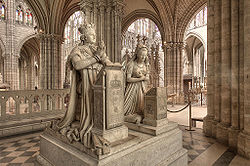 Memorial to King Louis XVI and Queen Marie Antoinette, sculptures by Edme Gaulle and Pierre Petitot
Memorial to King Louis XVI and Queen Marie Antoinette, sculptures by Edme Gaulle and Pierre Petitot
Napoleon Bonaparte reopened the church in 1806, but allowed the royal remains to be left in their mass graves. During Napoleon's exile in Elba, the restored Bourbons ordered a search for the corpses of Louis XVI and Marie Antoinette. The few remains, a few bones that were presumably the king's and a clump of greyish matter containing a lady's garter, were found on January 21, 1815, brought to Saint-Denis and buried in the crypt. In 1817 the mass graves containing all the other remains were opened, but it was impossible to distinguish any one from the collection of bones. The remains were therefore placed in an ossuary in the crypt of the church, behind two marble plates with the names of the hundreds of members of the succeeding French dynasties that were interred in the church duly recorded.
King Louis XVIII, upon his death in 1824, was buried in the center of the crypt, near the graves of Louis XVI and Marie Antoinette. The coffins of royal family members that died between 1815 and 1830 were also placed in the vaults. Under the direction of architect Viollet-le-Duc, famous for his work on Notre-Dame de Paris, church monuments that were taken to the Museum of French Monuments were returned to the church. The corpse of King Louis VII, who had been buried at the Abbey at Saint-Pont and whose tomb had not been touched by the revolutionaries, was brought to Saint-Denis and buried in the crypt. In 2004 the mummified heart of the Dauphin, the boy that would have been Louis XVII, was sealed into the wall of the crypt.
Burials
Charles I of Naples (or Anjou).
 Tomb of Charles Martel.
Tomb of Charles Martel. Tomb of Philip IV.
Tomb of Philip IV.
 Saint Denis Basilica - (From left clockwise) Gisants Bertrand du Guesclin, Charles VI, Isabeau of Bavaria, Louis de Sancerre, Charles V, Jeanne de Bourbon
Saint Denis Basilica - (From left clockwise) Gisants Bertrand du Guesclin, Charles VI, Isabeau of Bavaria, Louis de Sancerre, Charles V, Jeanne de Bourbon
Kings
All but three of the Kings of France are buried in the basilica, as well as a few other monarchs. The remains of the earlier monarchs were removed from the destroyed Abbey of St Genevieve. Some of the prominent of these are:
- Clovis I (465 - 511)
- Childebert I (496 - 558)
- Arégonde (c.515 - c.573)
- Fredegonde (Wife of Chilperic I of Neustria) (? - 597)
- Dagobert I (603 - 639)
- Clovis II (635 - 657)
- Charles Martel (686 - 741)
- Pippin the Younger (714 - 768) and his wife Bertrada of Laon (726-783)
- Carloman I King of the Franks (c.751 - 771)
- Charles the Bald (823 - 877) (his monument was melted down) and his wife, Ermentrude of Orléans (823 - 869)
- Carloman (866 - 884)
- Robert II the Pious (972–1031) and Constance of Arles (c. 986 - 1032)
- Henry I (1008–1060)
- Louis VI (1081–1137)
- Louis VII (1120–1180) and Constance of Castile (1141–1160)
- Philip II Augustus (1180–1223)
- Charles I of Naples (1226–1285), king of the Two Sicilies (1266–85). An effigy covers his heart burial.
- Philip III the Bold (1245–1285)
- Philip IV the Fair (1268–1315) and Isabella of Aragon (1247 – 1271)
- Leo V of Armenia (1342–1393)
- Louis XII of France (1462–1515)
- Francis I (1494–1547)
- Henry II (1519–1559) and Catherine de' Medici (1519 – 1589)
- Francis II (1544 – 1560)
- Charles IX (1550–1574) (no monument)
- Henry III (1551–1589), also King of Poland (heart burial monument)
- Henry IV (1553–1610)
- Louis XIII (1601 – 1643)
- Louis XIV (1638 – 1715)
- Louis XV (1710 – 1774),
- Louis XVI (1754 – 1793) and Marie Antoinette (1755 – 1793)
- Louis XVII (1785–1795) (Only his heart. His body was dumped into a mass grave)
- Louis XVIII (1755–1824)
Other royalty and nobility
- Nicolas Henri, Duke of Orléans (1607–1611), son of Henry IV,
- Gaston, Duke of Orléans (1608–1660), son of Henry IV,
- Marie de Bourbon, Duchess of Montpensier (1605–1627), wife of Gaston,
- Marguerite of Lorraine (1615–1672), Duchess of Orléans and second wife of Gaston,
- Anne Marie Louise d'Orléans (1627–1693), la Grande Mademoiselle,
- Marguerite Louise d'Orléans (1645–1721), Grand Duchess of Tuscany,
- Jean Gaston d'Orléans, (1650–1652), Duke of Valois,
- Marie Anne d'Orléans, (1652–1656), Mademoiselle de Chartres
- Henrietta Maria of France (1609–1669), queen consort of Charles I of Scotland and England,
- Philippe I, Duke of Orléans, (1640–1701), brother of Louis XIV,
- Princess Henriette Anne of England (1644–1670), first wife of Philippe,
- Elizabeth Charlotte of the Palatinate (1652–1722), second wife of Philippe,
- Maria Theresa of Spain (1638–1683), consort of Louis XIV,
- Louis of France (1661–1711), le Grand Dauphin,
- Duchess Maria Anna of Bavaria (!660-1690), Dauphin of France, wife of Louis,
- Princess Anne Élisabeth of France (1662), daughter of Louis XIV,
- Princess Marie Anne of France (1664), daughter of Louis XIV,
- Marie Thérèse of France (1667–1672), daughter of Louis XIV,
- Philippe Charles of France (1668–1671), Duke of Anjou, son of Louis XIV
- Louis François of France (1672), Duke of Anjou, son of Louis XIV,
- Philippe II, Duke of Orléans (1674–1723), Regent of France,
- Louis of France (1682–1712), Duke of Burgundy,
- Maria Adelaide of Savoy (1685–1712), Duchess of Burgundy,
- Louis of France (1704–1705), Duke of Brittany,
- Louis of France (1707–1712), Duke of Brittany,
- Charles of France (1686–1714), Duke of Berry,
- Marie Louise Élisabeth d'Orléans (1693–1714), Duchess of Berry,
- Na (not baptized) d'Alençon (1711)
- Charles d'Alençon(1713) Duke of Alençon,
- Marie Louise Élisabeth d'Alençon (1714)
- Marie Leszczyńska (1703–1768), consort of Louis XV,
- Marie Louise Élisabeth of France (1727–1759), Duchess of Parma,
- Princess Anne Henriette of France (1727–1752), daughter of Louis XV and twin of the above,
- Princess Marie Louis of France (1728–1733), daughter of Louis XV,
- Louis of France (1729–1765), Dauphin of France,
- Infanta Maria Teresa Rafaela of Spain (1726–1746), first wife of above,
- Maria Josepha of Saxony (1731–1767), second wife of Louis,
- Philippe of France (1730–1733), Duke of Anjou,
- Princess Marie Adélaïde of France (1732–1800), daughter of Louis XV,
- Princess Victoire of France (1733–1799), daughter of Louis XV,
- Princess Sophie of France (1734–1782), daughter of Louis XV,
- Princess Louise Marie of France (1737–1787), daughter of Louis XV,
- Louis Joseph, Dauphin of France (1781–1789), first son of Louis XVI and Marie Antoinette
- Princess Sophie Hélène Béatrice of France (1786–1787), second daughter of Louis XVI and Marie Antoinette
Gallery
-
Tomb of Dagobert I
-
Depiction of the Trinity over the main entrance
See also
Notes
- ^ Banister Fletcher, A History of Architecture on the Comparative Method.
- ^ Vita S. Eligius, edited by Levison, on-line at Medieval Sourcebook
- ^ Sumner McKnight Crosby, The Royal Abbey of Saint-Denis from Its Beginnings to the Death of Suger, 475-1151, Yale University Press, 1987
- ^ Lindy Grant, Abbot Suger of St.Denis: Church and State in Early Twelfth-century France, Longman, 1998
- ^ Fordham College Medieval Sourcebook, "Abbot Suger: ON WHAT WAS DONE IN HIS ADMINISTRATION", Chapter XXV: Concerning the First Addition to the Church
- ^ Lindy Grant, Abbot Suger of St. Denis: Church and State in Early Twelfth-Century France, Addison Wesley Longman Limited, 1998
- ^ Stephen Gardner, "Two Campaigns in Suger’s Western Block at Saint-Denis", Art Bulletin, Vol.44, part 4, 1984, pp. 574–87
- ^ William Chester Jordan, A Tale of Two Monasteries: Westminster and Saint-Denis in the thirteenth century (Princeton: Princeton University Press, 2009) Chapters 2-7.
- ^ . Pamela Blum, Early Gothic Saint-Denis: Restorations and Survivals, Berkeley, 1992
- ^ Fordham College Medieval Sourcebook, "Abbot Suger: ON WHAT WAS DONE IN HIS ADMINISTRATION", Chapter XXVII: Concerning the Cast and Gilded Doors
- ^ H. Honour and J. Fleming, The Visual Arts: A History. Upper Saddle River, NJ: Pearson Prentice Hall, 2005. ISBN 0-13-193507-0
- ^ "L'art Gothique", section: "L'architecture Gothique en Angleterre" by Ute Engel: L'Angleterre fut l'une des premieres régions à adopter, dans la deuxième moitié du XIIeme siècle, la nouvelle architecture gothique née en France. Les relations historiques entre les deux pays jouèrent un rôle prépondérant: en 1154, Henri II (1154–1189), de la dynastie Française des Plantagenêt, accéda au thrône d'Angleterre." (England was one of the first regions to adopt, during the first half of the 12th century, the new gothic architecture born in France. Historic relationships between the two countries played a determining role: in 1154, Henry II (1154–1189), of the French Plantagenet dynasty, assended to the throne of England).
- ^ John Harvey, The Gothic World
- ^ Georgia Sommers Wright, "A Royal Tomb Program in the Reign of St Louis", in The Art Bulletin, Vol.56, No.2 (Jun 1974) pp.224-43
- ^ Christopher Wilson, The Gothic Cathedral: The Architecture of the Great Church 1130-1530, Thames & Hudson, 1992
- ^ Caroline Bruzelius, The Thirteenth-century Church at St-Denis, New Haven, 1985
- ^ Images of Medieval Art and Architecture - Félibien accessed March 29, 2009
References
- Félibien, Michel. 1973. Histoire de l'abbaye royale de Saint-Denys en France: Lettre-préf. de M. le Duc de Bauffremont. Introd. de Hervé Pinoteau. 1. [Nachdr. d. Ausg. Paris, 1706]. - 1973. - 524 S. Paris: Éd. du Palais Royal.
- Saint-Denis Cathedral, Alain Erlande-Brandenburg, Editions Ouest-France, Rennes
External links
Wikimedia Commons has media related to: - Detailed list of members of the French Royal families buried in Saint Denis Basilica
- The Treasures of Saint Denis - scholarly article from 1915 on the important and mostly destroyed treasures
- L'Internaute Magazine: Diaporama (French)
- Satellite image from Google Maps
- Saint-Denis, a town in the Middle Ages
- Photos of tombs and the Basilica (French)
Categories:- 1130s architecture
- Benedictine monasteries in France
- Buildings and structures in Seine-Saint-Denis
- Cathedrals in France
- 12th-century church buildings
- Official historical monuments of France
- Roman Catholic churches in France
- Gothic architecture in France
Wikimedia Foundation. 2010.

